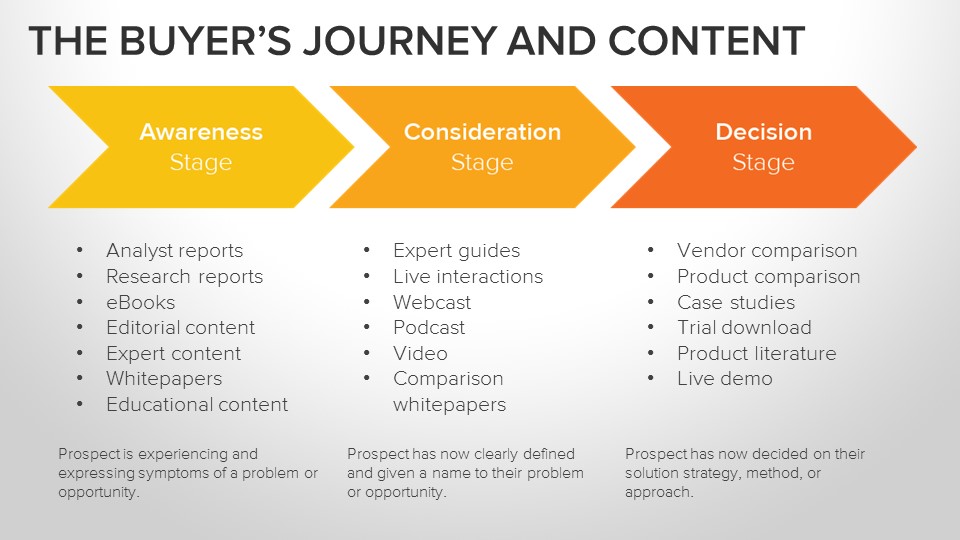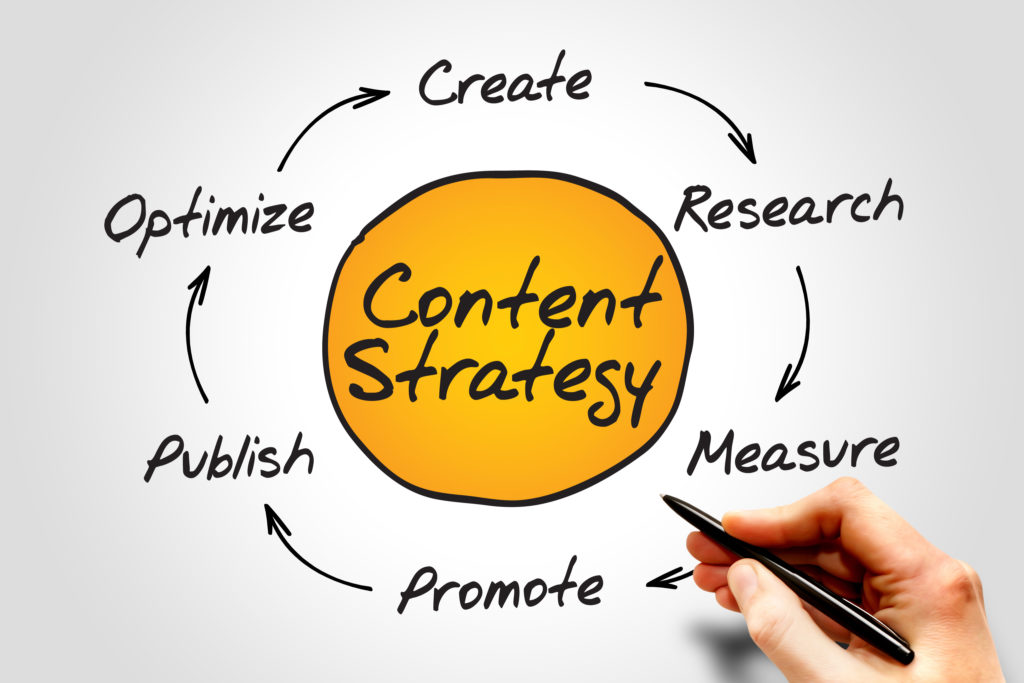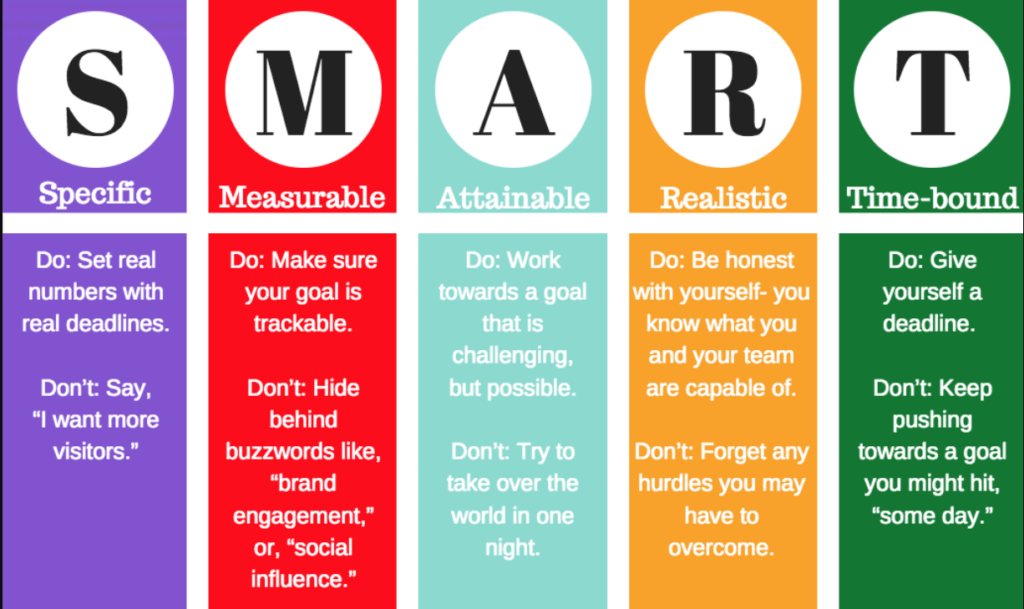We’ve all heard it before – content is king. It’s the reason why businesses and their marketing teams put in so much effort creating blog posts, e-books, white papers, case studies and more. A picture may be worth a thousand words but when it comes to business, nothing beats some good, old-fashioned writing!
In this article,
- Why your business needs a content marketing strategy
- B2B marketers, give this some thought
- Build your ideal B2B content marketing strategy
- Set clear goals
- Develop buyer personas
- Audit your content
- Brainstorm new content ideas
- Identify keywords and search intent
- Lean on topic clusters
- Pick the right content types
- Figure out how to create and manage your content
- Get your employees involved
- Promote your content
- Look at your metrics
- Repurpose and update your content
- How can Social Animal help you create your own B2B content marketing strategy?
Why your business needs a content marketing strategy
High-quality content is always an asset to your brand. However, even the best content can fall flat if it doesn’t come with a well-structured strategy.
A content marketing strategy is basically your own unique instruction manual on how to use different types of content to achieve the results that you want. To create content without a solid strategy in hand is like throwing darts with a blindfold on and hoping one of them lands on the target.
Here’s the only guide you’ll need to build a great #B2B Content #strategy.
via @socialanimal_io
Here’s how a B2B content marketing strategy can help you:
It can make you an authority in the field
When you search for information on a particular topic, you are usually presented with a wide variety of links for your use. Would you choose to spend your time on the website of an unknown company or the one that belongs to a reputable brand, known and trusted in your industry?
For B2B companies, being viewed as a reliable source can help aid your growth as a brand. Your content can help set you apart as an authority on the subject.
As you create more high-quality content, your audience will turn to you more frequently and look at you like the thought leaders in your industry. This can also help you attract better prospects for your B2B business.
It supports your business goals
Just like your general marketing strategy, your content marketing strategy, if implemented and used correctly, can support and help your B2B business move closer to its business goals.
Looking to increase awareness about a new product? Write a case study that shows how it performs and what problems it solves. Hoping to increase website traffic? Create a blog post focusing on the USPs of the services you provide and include links for people to use.
Tying in your B2B content marketing strategy to your business goals can lead to real, measurable growth for your brand.
It is cost-effective
B2B marketing is a tough world to navigate and it will require an investment of some sort on your part.
However, your content marketing efforts don’t have to burn a hole through your wallet. When compared to more traditional forms of marketing, B2B content marketing online can be cost-effective to get the word out about your business.
It can attract and keep customers
As your business continues to create great content and earn the trust of its audience, more people will be more likely to think of your company when they need a product that you offer. It’s one of the main reasons many B2B businesses create content on a regular basis – to find and engage potential customers.
However, you can also harness another segment of your audience who are located in a different part of your sales funnel – your existing customers. They are the unofficial ambassadors of your company, having bought and used your product or service.
By creating different types of content that speak to those located in different phases of the buyer’s journey, your audience will view you as a brand that is invested in providing value to its customers.
B2B marketers, give this some thought
You’re all fired up and ready to get this show on the road. But hold your horses, there are a few things you need to know and questions you need to answer before you can create a viable B2B content marketing plan.
Who are you trying to reach?
If you don’t know or understand your target audience very well, a lot of your content is going to fall flat on its face. This is a good time to do some research and figure out who will be consuming most of your content. The answer to this question will inform a big part of your strategy including the platforms on which you choose to showcase your content.
Audience research is a great marketing tactic if you want a clear direction when it comes to content creation. Ask your audience questions about how much time they spend on content, where they like consuming it, and what kind of content they would like to see.
Read: Marketing Research: Definition, Types & A How-To Guide
This can also generate ideas for content creation, leading to specific pieces tailored to different segments.
For more ideas on how to generate topics: 26 Article Ideas That’ll Actually Get You More Traffic
What problems are you trying to solve?
Your audience is looking for content for three main reasons:
- To find an answer to their question
- To find a solution for their problem
- To find a way to make a purchase
Your content needs to answer at least one of these questions, in order to add some value to your audience’s lives or businesses.
What is the USP of your content?
You may be talking to the right audience and offering information of great value, but no one is going to give your piece of content the time of day if it’s exactly like what everyone else is posting.
Your B2B content needs something that sets it apart from the competition. Give your audience a reason to choose your blog post or white paper over someone else’s.
What types of content do you want to create?
The type of content you create is an important part of your strategy. Do you want to start off small with blog posts on a regular basis? Or can you manage a separate social media schedule alongside this?
Remember to choose something that suits your business. Each type of content comes with its own set of advantages and disadvantages and are suited for specific types of audiences. Make sure you take all that into account when making this decision.
You might like: Short-form vs long-form content – Which is effective?
While creating content, you can also take a look into your archives and see if there is any content that you can repurpose in different formats. Sometimes, content of great value can be lost down the rabbit hole merely because it wasn’t utilized in the right way.
If you get the right combination in place, you could be seeing a whole lot of organic traffic headed your way.
Where will you be posting your content?
Once you’ve created your content, you’ll need your own space on the Internet to host it. Find a CMS with features that prove beneficial to your B2B content marketing strategy.
Pay attention to what you choose as this will be the central focus of your content strategy and the place to which you will be directing your audience.
Figure out on which social media channels you would like to have a presence. This will depend on your strategy, the type of content you plan to create as well as your target audience. Looking to get a young entrepreneurial audience with videos and infographics? Consider YouTube and Instagram. Want to reach an older audience with long, detailed blog posts? Try LinkedIn.
How will you measure your success?
Content marketing success shows up differently for different companies. It can change depending on your business goals, both long term and short term. Are you looking to increase lead generation? Are you hoping to increase organic traffic to your website?
Make sure you have tools in place to track, monitor and report how you are doing in these areas. You’ll understand if your content marketing tactics are working or if you need to start creating new content in a different direction.
Build your ideal B2B content marketing strategy
Once you have the answers to these questions, you are now ready to start constructing a personalized content strategy for your brand that will be the envy of B2B marketers everywhere.
Set clear goals
We’re starting right at the beginning with the goals you want to achieve.
According to research conducted by the Content Marketing Institute, the three most cited goals of B2B marketers were:
- Creating brand awareness (86%)
- Educating audience(s) (79%)
- Building credibility/trust (75%)
This changes for every business but there are a few things that you need to keep in mind when you put down the list of goals you want to accomplish through your online B2B marketing. First and foremost, figure out what you want from your content strategy – is it brand awareness, lead generation or trust building?
If you want to get your brand out there, maybe it’s time to create more blog posts and videos to circulate on social media. Or maybe it’s lead generation you’re looking for, in which case you may have to create more e-books and white papers. If it’s trust building you want, then maybe you should lead the way with thought leadership articles.
Keep your goals SMART – specific, measurable, attainable, relevant and time-bound. Ensure that your marketing goals are aligned with your business goals.
Develop buyer personas
A buyer persona is basically a representation of your customer with certain demographics and characteristics. If done accurately, it can help you create content that can help you achieve your content marketing goals.
This one requires a lot of research and consideration because it can be hard to draw the line between real-world features and stereotypes.
Make sure that you look at buyer personas from a more well-rounded perspective by addressing problems that the person can face, instead of their jobs.
When creating a buyer persona, focus on the people in the audience who are most likely to invest in your growth as a B2B company. This way, you get to tailor your content to speak to those who are most likely to convert.
Here are a few things to keep in mind while creating buyer personas:
- Take a good look at your audience and identify the features that they share. You can interview existing customers or refer to your database of user information that you have collected over time.
- Talk to your customers and prospects for a better understanding of what they want from you. Get their feedback and use it to construct a more accurate persona.
- Communicate with your sales team and find out what questions they get frequently, what problems customers want to solve with your products.
- Identify who your competitors view as their target audience and how they are attempting to reach out to them.
Audit your content
As a B2B company, you have probably already been creating content for your website, blog and different social media platforms. It’s time to dig deep into the archives and start your work for this one.
A content audit involves taking a closer look at your B2B content by cataloging it and analyzing its performance. This will help you identify the gaps in your past content strategy and fill them up in the new one.
Make note of what topics you have written about, how well your B2B content has been performing, whether you have been focusing too much on a certain topic while ignoring others.
Have you been producing content that focuses on different sections of the sales funnel or are you just focusing on acquisition? Are you strengthening ties with your audience or just creating content to get more leads?
A content audit will give you a clearer understanding of where you’re falling behind, where you’re doing well and how you can step things up.

Brainstorm new content ideas
When discussing new content as a B2B marketer, remember to keep your business goals at the fore. How will your new content contribute to achieving this goal? Content cannot be a passive, one-way street – it must have some direction that adds value to both your customers and your business. Include a call to action in the content you create.
While it may look like B2B content marketing is a job for marketers alone, your company’s content cannot be created in a vacuum. Marketing and sales must work hand-in-hand to create content that answers your customer’s questions.
The sales department will also have valuable feedback from customers who have used your product. Start creating content that incorporates this information into it, while addressing issues that crop up in different parts of the sales cycle. Your customers will appreciate it and it will help the sales team because they won’t have to answer the same question 50 times.
You can also reach out directly to your audience or take a look at related keywords to get some inspiration for new content. While user-generated content is more the norm for B2C content, it can also work for B2B marketing. After all, your prospects will be more willing to listen to other customers who have tried your product for themselves before reviewing it online.
Finally, do your research on what is already available online and see if you can add your own spin to it. Content marketing is not just about producing content on a regular basis – it’s about creating interesting content that adds value.
Identify keywords and search intent
It spells certain doom when your website fails to show on the first page of the results generated by search engines. Your B2B content strategy is incomplete without keyword research.
Use tools like Google Keyword Planner to identify keywords and related terms that you can use to optimize your content. You can also read through content created by brands in the same field to see what keywords they have used on a regular basis.
The trick is to identify keywords with lower rates of competition. This allows your website to rank better and therefore, show up early in searches.
Another thing to keep in mind is what your audience is trying to find. Customer intent is a vital part of your B2B content marketing strategy, especially while collecting keywords. If you find an article about a product similar to yours that is extremely popular during your research, try to identify what was the problem that triggered that particular search. It could give you a lot of information.
Intent is of three types – navigational, informational and transactional. Navigational intent refers to when a searcher is looking to find a certain page. Informational intent refers to a searcher asking questions like “how to” and looking for more information on a product or service. Transactional intent refers to a customer action like buying a product or signing up for a newsletter.
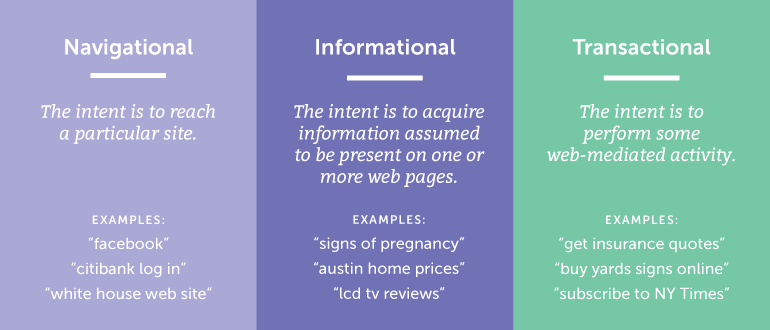
Lean on topic clusters
A topic cluster is basically a website page that reads like a digital PDF. It starts off with a broad topic or the pillar page before segmenting into a set of topics. These will give more detailed information on the main topic, while also linking out to other pieces of content for further reading.
Search engines are sneaky. While keywords are important in getting your content noticed, topic clusters can give your content the boost it needs in its rankings.
So, while your pillar page would satisfy the requirement for the main keyword, you can use different long-tail keywords for the related topics.
From your customer’s point of view, it will also be much easier to go through the content because of its structure.
Pick the right content types
Choosing the right content types for your business depend on many factors. Who will be consuming this content? Where will they be seeing this content? Will this format fit your business?
You should typically have an idea about what sort of content you would like to put out there by now, following your content audit.
If not, take a look at what competitors with similar audience bases are doing. Are they focusing more on blog content or does it look like their content marketing plan revolves around video?
Your final judgement should depend on what’s best for your business and its goals. Pick content types that will further your growth while connecting to your audience.
“If not, take a look at what competitors with similar audience bases are doing. Are they focusing more on blog content or does it look like their content marketing plan revolves around video?
Take a look at their images and visuals if they focus more on the blog content. “
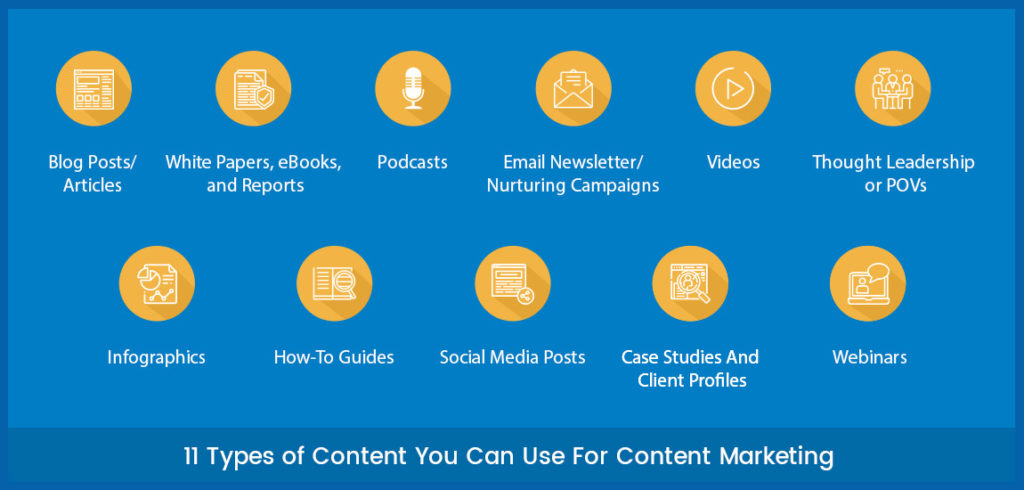
Figure out how to create and manage your content
This involves identifying a content management system (CMS) to get your blog or website up and running. It puts complete control of how you publish and update your content in your hands.
While producing your content is tough enough, creating a regular flow on content is also vital. You can do this with the help of a content calendar. Schedule content for a week or a month ahead of time and you’ll never have to run from pillar to post to find new content the day before you post.
A content calendar lists all the content you plan on creating for the period of time ahead for your blog, website or social media channels. It can help you plan out your content production beforehand and it gives you a bird’s eye view of what’s going up.
Too many pieces on the same topic in quick succession? Adjust your posting schedule or figure out what else you can create to act as a buffer.
Allow some room for flexibility in your calendar. Your content marketing should also focus on trends, both general and industry-specific. Keep an eye on what’s trending and if it relates to your brand, make fresh content that you can post instead of what’s planned for the day.
Get your employees involved
Not everyone has the resources to hire a dedicated marketing team – sometimes it’s just one person in front of a laptop, guzzling a lot of coffee.
Give your employees the chance to become content creators and leverage their skills to make content that represents your company. Some people may not be able to produce content, but they can help by promoting the company’s content. Your employees are your best spokespeople, after all!
Promote your content
If you post a piece of content and no one sees it, does it make a sound? The answer is no.
Great content means nothing if it doesn’t reach the audience that is meant to read it. You need to figure out which channels you can use to get the word out about you.
Social media channels are a great way to connect with your audience. Almost everyone has a social media account, for one reason or another. Figure out where your audience is spending most of their time and consuming the type of content you provide.
Different social media networks offer different benefits so choose the right one carefully. While Twitter is great for brand awareness, Instagram is better for nurturing leads.
Read: 18 Social Media Challenges Marketers Face in 2020
You can also promote your content through paid advertising, on search engines and social media. It’s a lot more cost-effective when compared to traditional advertising on newspapers and hoardings and it has the added benefit of being displayed only to your target base.
Another possibility is email marketing. Still seen by many as an important part of B2B marketing, email marketing can be used with great success to generate and nurture leads.

Look at your metrics
Analytics is a key part of B2B marketing. Without analytics, you’re just repeating the same process over and over with no clue about how well or how badly you’re doing.
Social media channels and content management systems do offer analytic reports. Make sure you take a look at them regularly to see whether you are making real strides in reaching your initial goals. It’s also a good way to figure out what’s working and what isn’t really doing it for your audience.
These reports help you understand which activities led to conversion from your audience. This includes information like a customer signing up for the online newsletter or clicking on “Confirm” after payment has gone through.
There are different attribution models to choose from and this will depend on your brand’s sale cycle.
Repurpose and update your content
Keep an eye on the content in your archives. It may contain products that are not produced anymore, statistics that need updating or even information that was proven to be wrong later. Update your content as required.
Old content can be repurposed to create fresh content formats. An old blog post can become a new infographic. A case study can take the form of a video. Repurposing content helps fill up your content calendars with ease.
How can Social Animal help you create your own B2B content marketing strategy?
- Find top engaged articles on major social platforms for any keyword. Analyze the headlines, length, type and sentiments of these articles to see why they’re performing well. This can help you create articles that are shareable. And you never run out of ideas, as you get millions of articles at your fingertips.
- Get insights on how articles related to any topic or keyword have performed historically, and on different social platforms.
- Find the kinds of content your competitors are publishing and the types of content that have worked for them. What works for them might work for you too.
- Find which social platform is the best suited for your brand. This tells you where most of your audience is and the type of content you need to create to reach them.
- Get to know days that have had higher engagement rates for any keyword. This helps you create your content calendar.
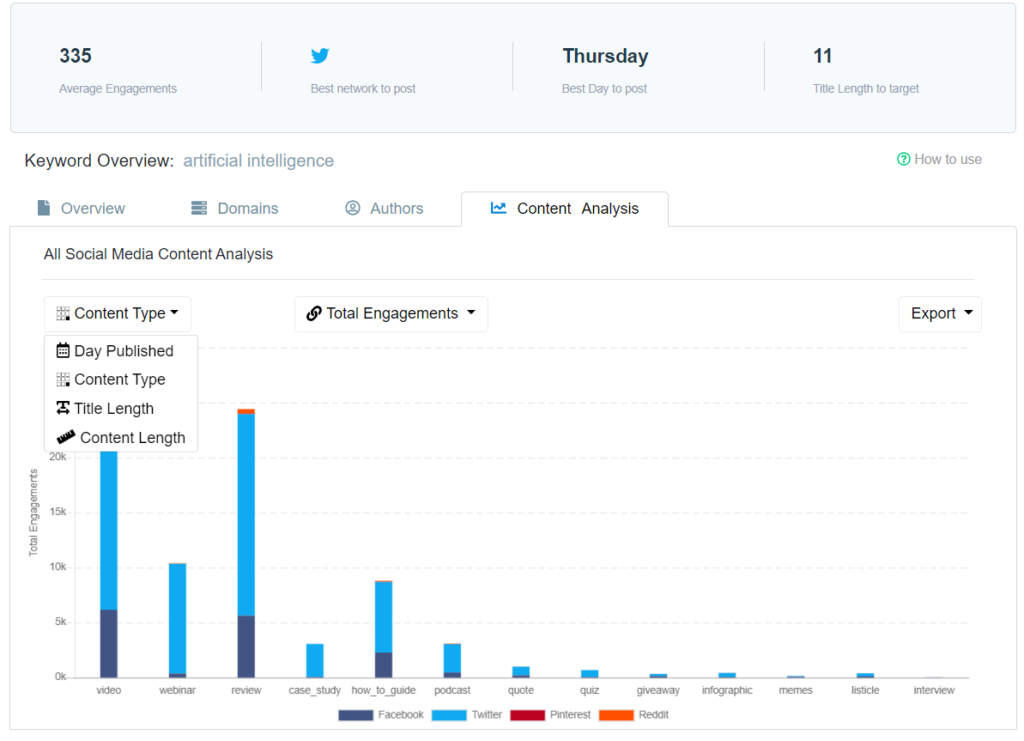
Create your content strategy now with Social Animal.
